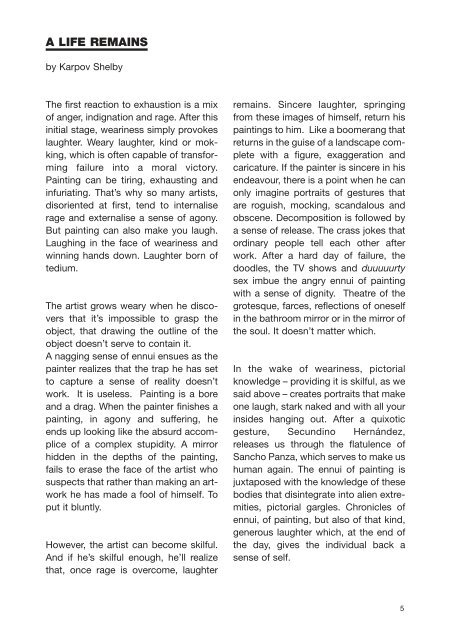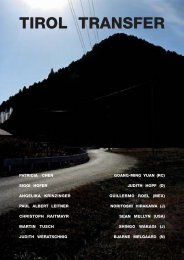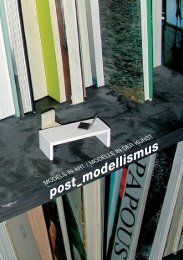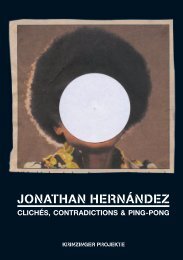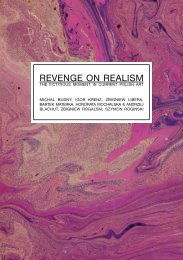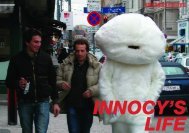Secundino Hernandez 2007 - krinzinger projekte - Galerie Krinzinger
Secundino Hernandez 2007 - krinzinger projekte - Galerie Krinzinger
Secundino Hernandez 2007 - krinzinger projekte - Galerie Krinzinger
You also want an ePaper? Increase the reach of your titles
YUMPU automatically turns print PDFs into web optimized ePapers that Google loves.
A LIFE REMAINS<br />
by Karpov Shelby<br />
The first reaction to exhaustion is a mix<br />
of anger, indignation and rage. After this<br />
initial stage, weariness simply provokes<br />
laughter. Weary laughter, kind or mokking,<br />
which is often capable of transforming<br />
failure into a moral victory.<br />
Painting can be tiring, exhausting and<br />
infuriating. That’s why so many artists,<br />
disoriented at first, tend to internalise<br />
rage and externalise a sense of agony.<br />
But painting can also make you laugh.<br />
Laughing in the face of weariness and<br />
winning hands down. Laughter born of<br />
tedium.<br />
The artist grows weary when he discovers<br />
that it’s impossible to grasp the<br />
object, that drawing the outline of the<br />
object doesn’t serve to contain it.<br />
A nagging sense of ennui ensues as the<br />
painter realizes that the trap he has set<br />
to capture a sense of reality doesn’t<br />
work. It is useless. Painting is a bore<br />
and a drag. When the painter finishes a<br />
painting, in agony and suffering, he<br />
ends up looking like the absurd accomplice<br />
of a complex stupidity. A mirror<br />
hidden in the depths of the painting,<br />
fails to erase the face of the artist who<br />
suspects that rather than making an artwork<br />
he has made a fool of himself. To<br />
put it bluntly.<br />
However, the artist can become skilful.<br />
And if he’s skilful enough, he’ll realize<br />
that, once rage is overcome, laughter<br />
remains. Sincere laughter, springing<br />
from these images of himself, return his<br />
paintings to him. Like a boomerang that<br />
returns in the guise of a landscape complete<br />
with a figure, exaggeration and<br />
caricature. If the painter is sincere in his<br />
endeavour, there is a point when he can<br />
only imagine portraits of gestures that<br />
are roguish, mocking, scandalous and<br />
obscene. Decomposition is followed by<br />
a sense of release. The crass jokes that<br />
ordinary people tell each other after<br />
work. After a hard day of failure, the<br />
doodles, the TV shows and duuuuurty<br />
sex imbue the angry ennui of painting<br />
with a sense of dignity. Theatre of the<br />
grotesque, farces, reflections of oneself<br />
in the bathroom mirror or in the mirror of<br />
the soul. It doesn’t matter which.<br />
In the wake of weariness, pictorial<br />
knowledge – providing it is skilful, as we<br />
said above – creates portraits that make<br />
one laugh, stark naked and with all your<br />
insides hanging out. After a quixotic<br />
gesture, <strong>Secundino</strong> Hernández,<br />
releases us through the flatulence of<br />
Sancho Panza, which serves to make us<br />
human again. The ennui of painting is<br />
juxtaposed with the knowledge of these<br />
bodies that disintegrate into alien extremities,<br />
pictorial gargles. Chronicles of<br />
ennui, of painting, but also of that kind,<br />
generous laughter which, at the end of<br />
the day, gives the individual back a<br />
sense of self.<br />
5


